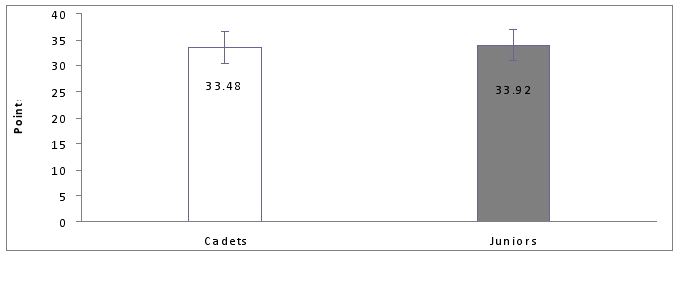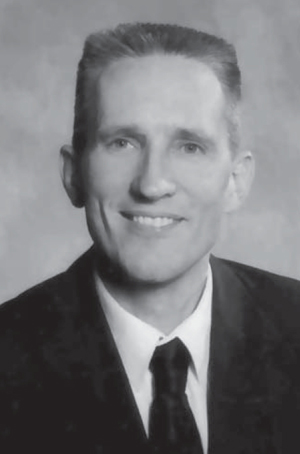Indicators of general and physical self-efficacy of representatives of youth basketball
Фотографии:
ˑ:
R.K. Malinauskas, professor, Dr.Hab.
А.R. Brusokas, assistant. Lithuanian Sports University, Kaunas, Lithuania
Key words: self-efficacy, basketball, youth sport, cadets, juniors.
Introduction. The relevance of the problem of person’s self-efficacy in sports in terms of practice is determined by the social significance of detecting and studying the way how to predict success in sports activities and how to improve sports results [2, 7]. However, the problems related to this field of research are understudied and the role of person’s self-efficacy of an adolescent athlete is still unknown.
The first researcher to focus on the person’s self-efficacy in the context of social learning theory was A. Bandura [1]. He defined self-efficacy as one’s belief in one’s ability to effectively direct one’s actions to achieve the set goals and succeed in completing a specific task [1]. Although the first ideas on self-efficacy have been propagated long time ago, even today it is impossible to state that this scientific problem has been fully solved. In most cases, both the writers of the Western world (e.g. A. Bandura, M. Erusalem, R. Schwarzer, M. Scherer, etc.) and the researches from the Eastern countries (e.g. L.V. Boyarintseva, E.A. Shepeleva, A.S. Ognev, etc.) analyzed general self-efficacy in the contexts of activities and communication [3]. In our opinion, it is particularly relevant to research this phenomenon in the context of youth sports (in our case, basketball). Adolescence and youth is the time of making important decisions and therefore it is important that an individual could make correct choices having considered objective factors and being aware of the assessment of his/her possibilities and capabilities, which would help to reveal his/her personal qualities significant in terms of sports.
The scientific problem of the research on general and physical self-efficacy of young basketball players aged 15–16 and those aged 17–18 in the lack of unambiguous opinion regarding the differences of general and physical self-efficacy in terms of cadet and junior basketball players. Moreover, the scientific problems researched in this study are also based on the asked question as well as the search for possible answers for the previous researches have been dedicated mostly to representatives of student basketball [5, 9] rather than those of adolescent and youth basketball. Earlier researches have revealed only the peculiarities of career self-efficacy of young basketball players [8].
Therefore, the question arising from the problem of the present study is as follows: what are the peculiarities of general and physical self-efficacy of young basketball players aged 15–16 and 17–18? Thus, we decided to establish the peculiarities of general and physical self-efficacy of cadet and junior basketball players.
Materials and methods. Two surveys were used in this study: the Generalized Self-Efficacy Scale by R. Schwarzer and M. Jerusalem, adapted by V. G. Romek [6], and the Physical Self-Efficacy Scale [10].
The Generalized Self-Efficacy Scale is comprised of ten statements. Each of the statements may be graded on a scale from 1 to 4 points. The respondent chooses one of the statements which seems most suitable to him/her (always – 4, sometimes – 3, very rarely – 2, never – 1). The respondent may receive the minimum of 10 points. The maximum possible amount of points equals 40. The general self-efficacy level is considered to be low when the collected points range from 10 to 20, average in case of 21–30 collected points, and high if the respondent got between 31 and 40 points. High level of self-efficacy is related to very good mental and physical health, better luck and improved social integration. The scale has positive correlation with self-respect and optimistic attitude and a negative one with personal and situational anxiety, timidity and pessimistic outlook. The internal consistency of the questionnaire was assessed based on the Cronbach’s alpha. The value of the Cronbach’s alpha coefficient for this sample was 0.73.
The Physical Self-Efficacy Scale is comprised of 22 items. The respondents have to grade the items from 1 to 6 points, where 1 point equals complete disagreement and 6 points mean complete agreement. The physical self-efficacy scale is substituted of the following two subscales: perceived physical ability subscale and a physical self-presentation confidence subscale. The perceived physical ability subscale includes 10 items which reflect how one understands his/her own physical abilities required to perform any physical tasks.
The value of the score may vary from 10 to 60 points. The physical self-presentation confidence subscale is constituted of 12 items. The scale shows one’s confidence in his/her physical abilities when they are viewed by other people favorably. The value of this score may vary from 12 to 72 points. The sum of the scores of both subscales represents the overall score of the physical self-efficacy. The results may vary from 22 to 132 points. High results reflect high level of physical self-efficacy.
The level of perceived physical ability is considered low when the respondent collects from 10 to 25 points, average in case of 26–45 points, and high if 46–60 points are received. The physical self-presentation confidence is low in case of 12–32 collected points, average in case of 33–56 points and high if the respondent gets 57–72 points. The physical self-efficacy level (overall score) is perceived as low when it ranges from 22 to 54 points, average in case of 55–99 points, and high in case of 100–132 points. The internal consistency of the scale was assessed based on the Cronbach’s alpha. The value of the Cronbach’s alpha coefficient for the sample of the entire scale was 0.66 and that of the subscales – 0.61 and 0.62 respectively.
The Student’s t-test was employed to assess the significance of the differences of the general and physical self-efficacy scores of young basketball players aged 15–16 and 17–18. The statistical data analysis was performed with SPSS for Windows Version 13.0.
The sample size was formed by applying purposeful selection. The sample was constituted of the young basketball players from Lithuanian basketball schools. The sample size of the representatives of youth basketball selected for the research consisted of 219 cadets and 162 juniors.
Results and discussion. The results obtained from the questionnaire-based survey of the representatives of the Lithuanian youth basketball, i.e. cadets and juniors, helped to reveal their general self-efficacy level. It was determined that average level of general self-efficacy was inherent to cadets (33.48 ± 3.18) and juniors (33.92 ± 3.01). Also, the results shows that in terms of general self-efficacy level there were no statistically significant differences among the young basketball players of different age groups: t (379) = -1.36, p> 0.05 (Fig.).

Fig. Statistical indicators of general self-efficacy of young basketball players (M±SD)
According to the findings, the juniors were more confident of their physical abilities (Table 2), because their respective ratio level was higher than that of the cadets (t (379) = -2.58, p <0.05). Also, no significant differences were observed in perceived physical abilities among the young basketball players aged 15–16 and 17–18. The following statistically significant (t (379) = -2.11, p <0.05) difference was found in terms of the physical self-efficacy level among young basketball players of different age groups: the physical self-efficacy level of juniors was higher than that of cadets.
Table. Statistical indicators of the physical self-efficacy of young basketball players (M±SD)
|
Indicators of physical self-efficacy |
Cadets (N=219) |
Juniors (N=162) |
t and р |
|
Perceived physical ability |
28,20±4,57 |
28,47±4,55 |
-0,58; p>0,05
|
|
Physical Self-Presentation Confidence |
36,89±6,09 |
38,48±5,75 |
-2,58; p<0,05 |
|
Level of physical self-efficacy (Overall Score of physical self-efficacy) |
65,09±8,67 |
66,95±8,32 |
-2,11; p<0,05 |
The received results show that it is possible to create favorable conditions during training sessions to improve physical self-efficacy. Therefore, it is hardly surprising that higher physical self-efficacy level is inherent to the young basketball players of the older age group. As far as it concerns the observation that the cadets and the juniors typically have common social qualities [7], the data gathered during the present research are similar to the data of earlier conducted studies. Thus, no statistically significant difference has been revealed among them in terms of general self-efficacy. However, our study suggested that juniors have higher confidence in their own physical abilities in comparison to cadets. These results do not differ from those obtained in other studies which show that there are differences in psychological resources among the adolescents and young people engaged in sports [4].
We believe that this study which is based on the analysis whether or not general and physical self-efficacy of youth basketball representatives belonging to different age groups has practical value because its results may help basketball coaches to make right choices when working with young basketball players. This may be achieved by devoting more attention to psychological preparation as the problem of self-efficacy is especially relevant during competitions when flexible thinking and behavior of players is as important as their good physical condition [2].
Conclusions. The studies have not revealed any statistically significant differences among the young basketball players (cadets and juniors) of different age groups. The research results revealed that the physical self-efficacy level of junior basketball players was higher than that of the cadets. Also, the juniors had higher self-confidence in their physical abilities than the cadets.
References
1. Bandura, A. Theory of social teaching / A. Bandura. – St.Petersburg: Evraziya, 2000. – 320 P. (In Russian)
2. Bulynko, N.A. The model of self-efficiency of athlete’s personality / N.A. Bulynko // Psikhologicheskiy zhurnal. – 2009. – № 2 (22) – P. 95–102. (In Russian)
3. Gordeeva, T.O. Gender differences in academic and social self-efficiency and coping-strategies within modern Russian teenagers / T.O. Gordeeva, E.A. Shepeleva // Vestnik MGU. Psychology. – Series 14. М., 2006. – № 3. – P. 78–85. (In Russian)
4. Malinauskas, R.K. Characteristics of mental reliability of basketball players of different qualifications / R.K. Malinauskas, A.R. Brusokas // Fizicheskoe vospitanie studentov. – 2010. – № 1. – P. 80–82. (In Russian)
5. Malinauskas, R.K. The dynamics of sociopsychological competency of pedagogical university students / R.K. Malinauskas, V.P. Gudonis, Sh.A. Shniras // Psikhologicheskiy zhurnal. – 2007. – V. 28. – № 4. – P. 45–51. (In Russian)
6. Schwarzer, R. The Russian version of the generalized self-efficacy scale by R. Schwarzer and M. Jerusalem / R. Schwarzer, M. Jerusalem, V. Romek // Inostrannaya psikhologiya. – 1996. – № 7. – P. 46–56. (In Russian)
7. Malinauskas R. Self-efficacy concept and characteristics of athletes self-efficacy / R. Malinauskas, A. Brusokas // Science and processes in education. – 2010. – Vol. 13, № 4. – P. 68–80.
8. Malinauskas R. Peculiarities of career self-efficacy of young basketball players / R. Malinauskas, A. Brusokas, V. Gudonis // European Journal of Contemporary Education. – 2012. – Vol. 1, № 1. – P. 30-33.
9. Malinauskas R. Self-efficacy among students of pedagogical universities / R. Malinauskas, V. Malinauskienė, Ž. Vazne, D. Pancekauskas // European Researcher. – 2012. – Vol. 18, №. 3. – P. 301-305.
10. Ryckman R.M. Physical self efficacy scale [PSE] / R.M. Ryckman, M.A. Robbins, B. Thornton, P. Cantrell // Measures for clinical practice: A sourcebook / Red. K. Corcoran, J. Fischer. New York: Free Print, 1982. – Vol. 2. – P. 586–588.
Author’s contacts: r.malinauskas@lkka.lt



 Журнал "THEORY AND PRACTICE
Журнал "THEORY AND PRACTICE